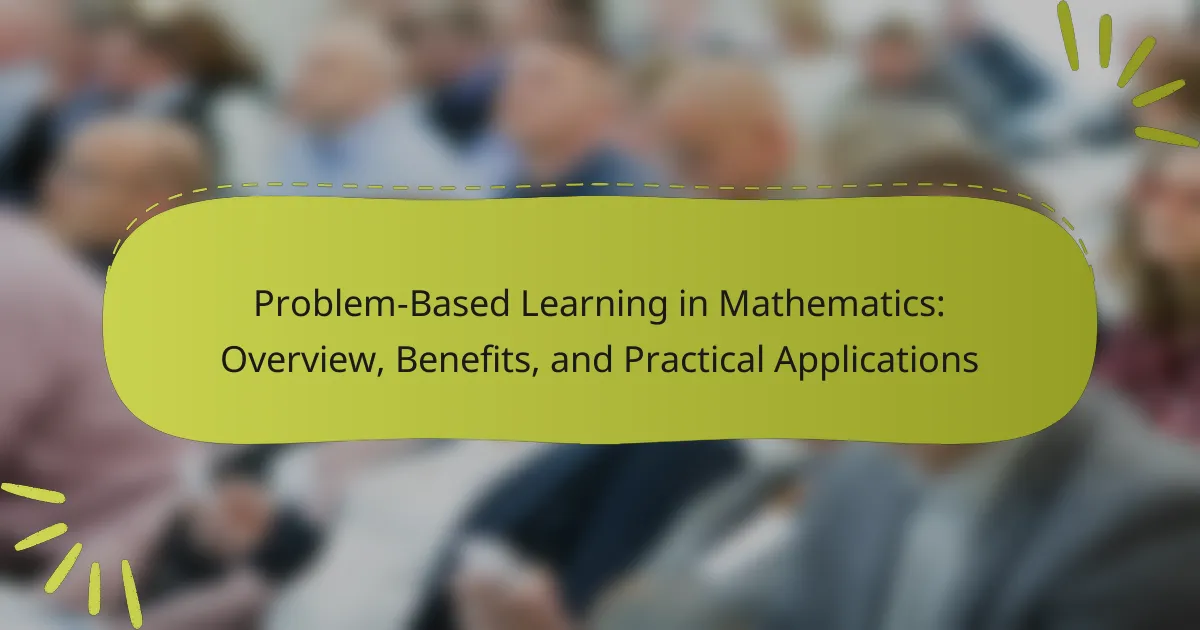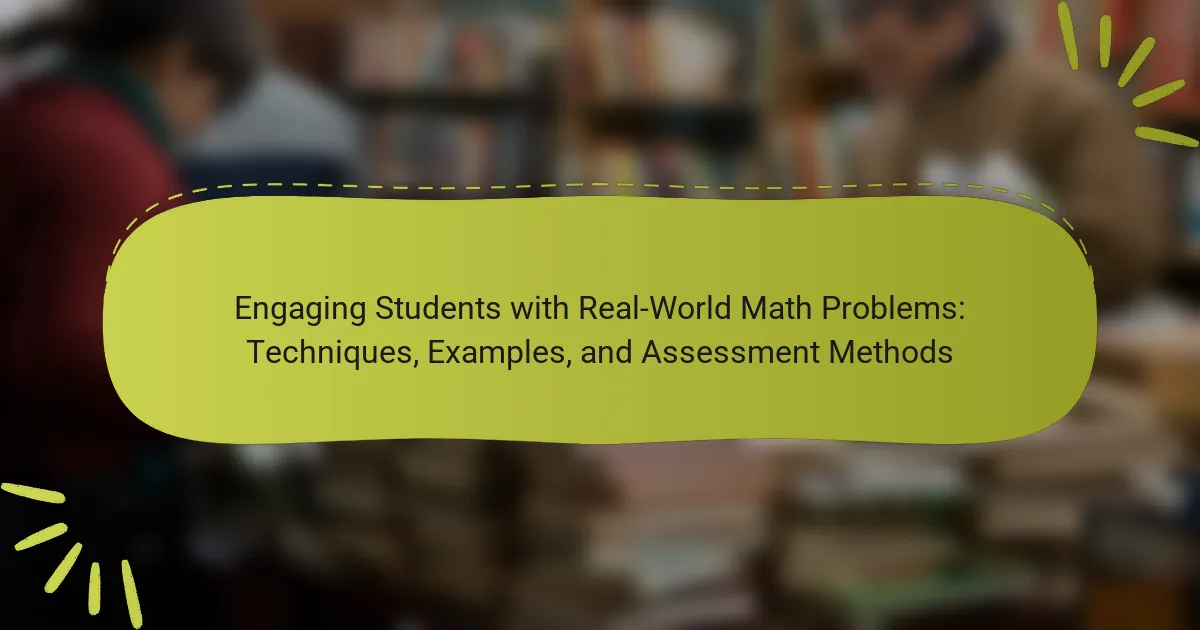Formative assessment is a vital process in math teaching that provides continuous feedback to educators and learners, helping to identify understanding and misconceptions in real-time. This article explores the significance of formative assessment, highlighting its ability to enhance student learning outcomes through effective implementation and regular frequency, ideally every 2-3 weeks. Key strategies for successful formative assessment include using diverse assessment methods, providing timely feedback, aligning assessments with learning objectives, involving students in self-assessment, and utilizing data to inform instruction. Research underscores the positive impact of formative assessments on student achievement, emphasizing the importance of fostering a growth mindset in the learning environment.
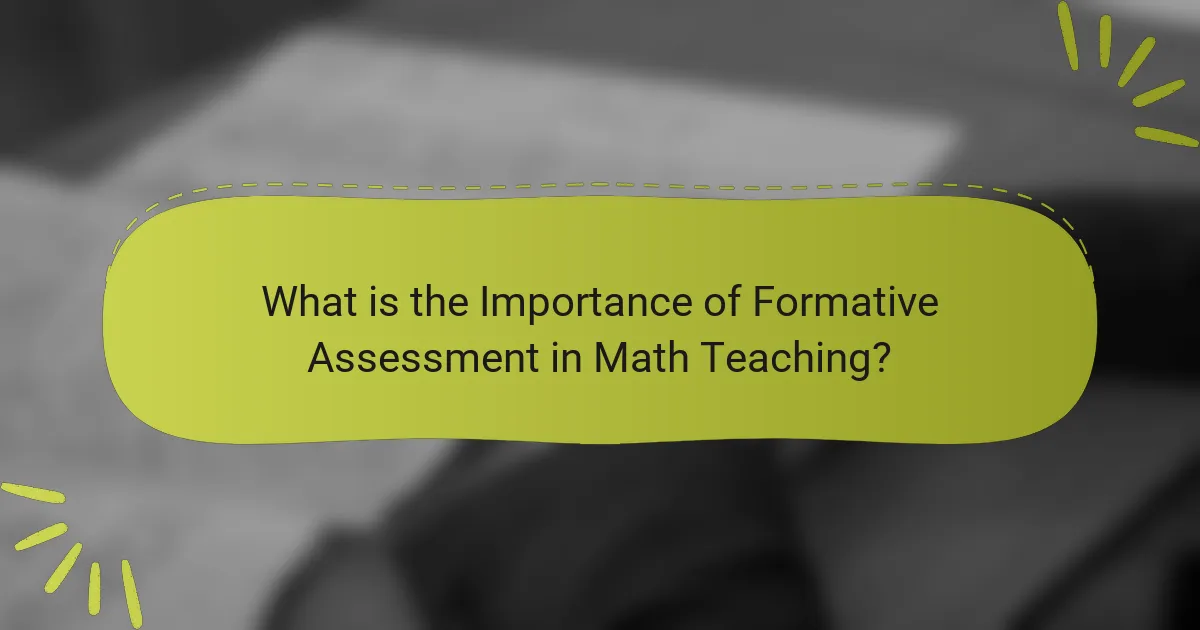
What is the Importance of Formative Assessment in Math Teaching?
Formative assessment is crucial in math teaching as it provides ongoing feedback to both teachers and students. This type of assessment helps identify students’ understanding and misconceptions in real-time. It enables teachers to adjust instruction based on students’ needs. Research shows that formative assessment can significantly enhance student learning outcomes. According to Hattie and Timperley’s meta-analysis, feedback from formative assessments can lead to a 0.79 effect size on student achievement. This indicates a substantial impact on learning when formative assessments are effectively implemented. By fostering a growth mindset, formative assessment encourages students to engage actively in their learning process.
How does formative assessment differ from summative assessment?
Formative assessment is an ongoing process used to monitor student learning and provide feedback. It occurs during the learning process and helps identify areas for improvement. Summative assessment, on the other hand, evaluates student learning at the end of an instructional unit. It measures what students have learned and assigns grades or scores. Research shows that formative assessments can lead to improved student performance by guiding instruction. In contrast, summative assessments typically do not influence future teaching strategies.
What are the key characteristics of formative assessment?
Formative assessment is a process used to monitor student learning and provide ongoing feedback. It focuses on improving student understanding and performance. Key characteristics include being continuous, allowing for adjustments in teaching, and emphasizing student involvement. Formative assessments are often informal and can take various forms, such as quizzes, discussions, or observations. They provide immediate feedback to both students and teachers. This feedback helps identify learning gaps and informs future instruction. Research indicates that formative assessment can lead to significant improvements in student achievement. For instance, a meta-analysis by Hattie (2009) showed that formative assessment has a high effect size on learning outcomes.
Why is formative assessment critical in math education?
Formative assessment is critical in math education because it provides ongoing feedback to both teachers and students. This type of assessment helps identify students’ understanding and misconceptions in real-time. By regularly assessing students’ progress, educators can tailor instruction to meet individual needs. Research indicates that formative assessments can significantly improve student achievement. For instance, a study by Black and Wiliam (1998) found that formative assessment practices can raise student performance by an average of 20 percentile points. This evidence underscores the importance of integrating formative assessment into math curricula.
What strategies can be used for effective formative assessment in math?
Effective formative assessment in math can be achieved through various strategies. One effective strategy is the use of exit tickets. These short assessments allow teachers to gauge student understanding at the end of a lesson. Another strategy is peer assessment, where students evaluate each other’s work. This promotes collaboration and deeper understanding of concepts.
Additionally, incorporating frequent quizzes can provide immediate feedback. These quizzes help identify areas needing improvement. Utilizing observational assessments during group work also offers insights into student comprehension. Teachers can adjust instruction based on these observations.
Another method is the use of digital tools for real-time feedback. Platforms like Kahoot! or Google Forms facilitate instant responses. Finally, providing differentiated tasks based on student readiness ensures all learners are assessed appropriately. These strategies collectively enhance the effectiveness of formative assessment in math.
How can teachers implement formative assessment techniques in the classroom?
Teachers can implement formative assessment techniques in the classroom by using various strategies. These include regular quizzes, exit tickets, and peer assessments. Teachers can also incorporate observational assessments during group activities. Providing immediate feedback is essential for student growth. Utilizing digital tools for real-time data collection enhances engagement. Collaborative learning opportunities allow for peer feedback and self-assessment. Research indicates that formative assessment improves student performance and understanding. For instance, a study by Black and Wiliam (1998) found that formative assessment significantly boosts achievement in mathematics.
What role does feedback play in formative assessment strategies?
Feedback is essential in formative assessment strategies as it guides student learning and improvement. It provides specific insights into student performance. This information helps educators identify areas needing support. Feedback fosters a growth mindset by encouraging students to reflect on their learning. Research shows that timely feedback can enhance student achievement significantly. For example, Hattie and Timperley’s study (2007) found that feedback is one of the most powerful influences on learning outcomes. Effective feedback informs instructional adjustments and enhances the overall teaching process. Thus, feedback is a critical component in the success of formative assessments.
What are the key benefits of using formative assessment in math teaching?
Formative assessment in math teaching enhances student learning and understanding. It provides immediate feedback to students, allowing them to identify their strengths and weaknesses. This continuous evaluation helps teachers adjust their instruction based on student needs. Research shows that formative assessment can lead to improved academic performance. A study by Black and Wiliam (1998) indicates that effective formative assessment can increase student achievement by up to 30%. It also promotes student engagement and motivation. Students become more active participants in their learning process. Overall, formative assessment fosters a growth mindset and encourages a deeper understanding of mathematical concepts.
How does formative assessment enhance student learning outcomes?
Formative assessment enhances student learning outcomes by providing ongoing feedback that informs instruction. This type of assessment allows teachers to identify students’ strengths and weaknesses in real-time. It encourages active engagement and self-reflection among students. Research indicates that formative assessment can lead to a 20% increase in student achievement (Black & Wiliam, 1998). By adjusting teaching strategies based on assessment results, educators can better meet individual learning needs. This targeted approach fosters a deeper understanding of the material. Overall, formative assessment creates a responsive learning environment that promotes academic growth.
What impact does formative assessment have on teacher instruction?
Formative assessment positively impacts teacher instruction by providing real-time feedback on student understanding. This feedback allows teachers to identify learning gaps and adjust their teaching strategies accordingly. Research shows that formative assessment leads to improved student outcomes. According to Black and Wiliam (1998), effective use of formative assessment can raise student achievement by as much as 30%. Teachers who implement formative assessments can tailor their instruction to meet the diverse needs of their students. This adaptability fosters a more responsive learning environment. Overall, formative assessment enhances the quality of teaching and learning in the classroom.
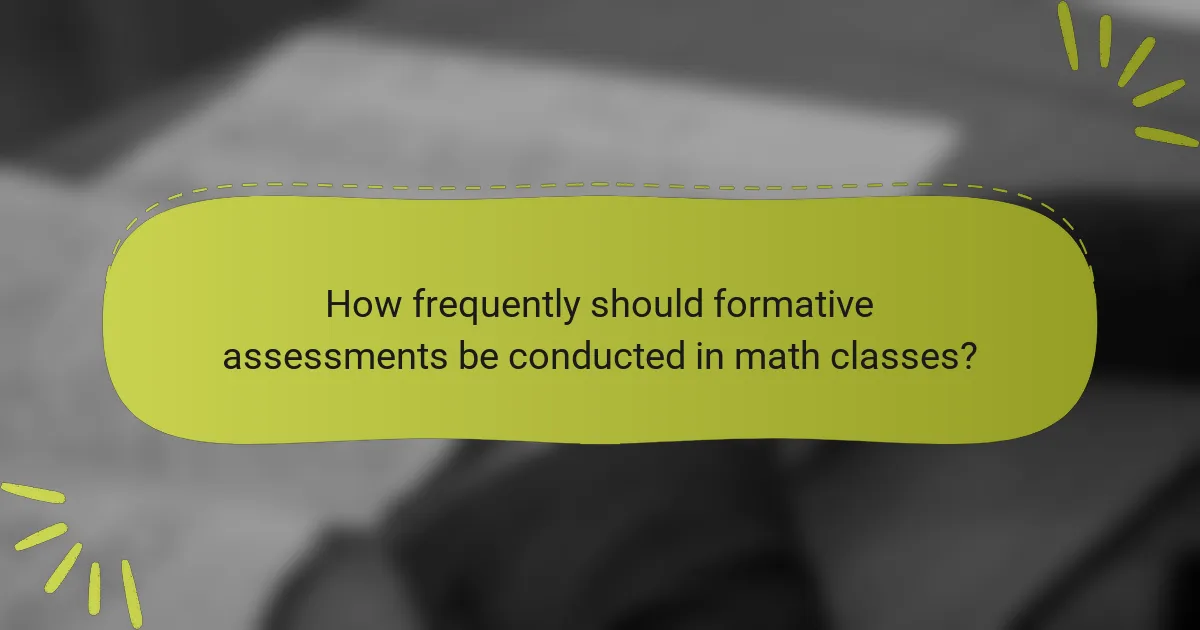
How frequently should formative assessments be conducted in math classes?
Formative assessments should be conducted regularly in math classes, ideally every few weeks. This frequency allows teachers to gauge student understanding and adjust instruction accordingly. Research shows that frequent formative assessments can significantly enhance student learning outcomes. A study by Black and Wiliam (1998) found that formative assessment practices lead to improved academic performance. Therefore, implementing assessments every 2-3 weeks is recommended to monitor progress effectively.
What factors influence the frequency of formative assessments?
The frequency of formative assessments is influenced by several factors. First, the learning objectives set by educators play a crucial role. Clear objectives guide the timing and nature of assessments. Second, the instructional strategies employed affect how often assessments occur. Active learning techniques may require more frequent checks for understanding. Third, student needs and responses dictate assessment frequency. Teachers often adjust based on student performance and engagement levels. Fourth, curriculum demands can also shape assessment schedules. Some curricula integrate regular assessments to reinforce learning. Finally, classroom dynamics, such as size and diversity, influence how often formative assessments are implemented. Larger classes may limit individual feedback opportunities, affecting frequency.
How can teachers determine the appropriate timing for assessments?
Teachers can determine the appropriate timing for assessments by considering student readiness and curriculum pacing. Assessments should align with key learning objectives and instructional milestones. Teachers can analyze student performance data to identify when students have grasped essential concepts. Regular formative assessments allow for timely feedback, helping to adjust instruction as needed. Additionally, teachers can use observations and student engagement levels to gauge readiness for assessments. Research indicates that assessments conducted after significant teaching periods enhance retention and understanding. By integrating these strategies, teachers can effectively time assessments to maximize student learning outcomes.
What are the advantages of regular formative assessments?
Regular formative assessments enhance student learning and engagement. They provide immediate feedback, allowing educators to identify areas needing improvement. This feedback helps tailor instruction to meet individual student needs. Regular assessments also encourage active participation from students. They foster a growth mindset by showing progress over time. Research indicates that formative assessments can lead to higher academic achievement. For instance, a study by Black and Wiliam (1998) found that formative assessment practices significantly improve learning outcomes. These assessments also promote self-regulation and reflection among students.
How can teachers balance formative assessments with other teaching methods?
Teachers can balance formative assessments with other teaching methods by integrating them into daily instruction. They should use formative assessments as checkpoints to gauge student understanding. This allows teachers to adjust their teaching strategies based on real-time feedback. Additionally, blending formative assessments with summative assessments provides a comprehensive view of student progress. Research shows that consistent use of formative assessments can enhance student learning outcomes. According to Black and Wiliam (1998), effective formative assessment practices lead to improved academic performance. Teachers can also incorporate peer assessments and self-assessments to diversify their methods. This approach fosters student engagement and ownership of learning. Balancing these methods creates a dynamic learning environment that supports all students.
What integration strategies can enhance the effectiveness of formative assessments?
Integration strategies that enhance the effectiveness of formative assessments include aligning assessments with learning objectives. This ensures that assessments measure specific skills and knowledge. Utilizing technology can streamline data collection and analysis. Digital tools can provide immediate feedback to students. Incorporating peer assessments encourages collaborative learning and self-reflection. This practice promotes critical thinking and communication skills among students. Regularly revising assessment strategies based on student performance data can improve their relevance and effectiveness. Research shows that formative assessments linked to instructional strategies significantly boost student achievement. For instance, a study by Black and Wiliam (1998) found that formative assessments could raise student performance by up to 30 percent.
How can technology assist in conducting formative assessments?
Technology can assist in conducting formative assessments by providing tools for real-time feedback. Digital platforms enable instant data collection from student responses. Applications like online quizzes and polls allow teachers to gauge understanding immediately. Learning management systems facilitate tracking student progress over time. These technologies can analyze performance trends, helping educators adjust instruction accordingly. Interactive tools enhance engagement, making assessments more dynamic. Research shows that using technology in assessments can lead to improved learning outcomes. For instance, a study by Hattie (2012) emphasizes the positive impact of timely feedback on student achievement.
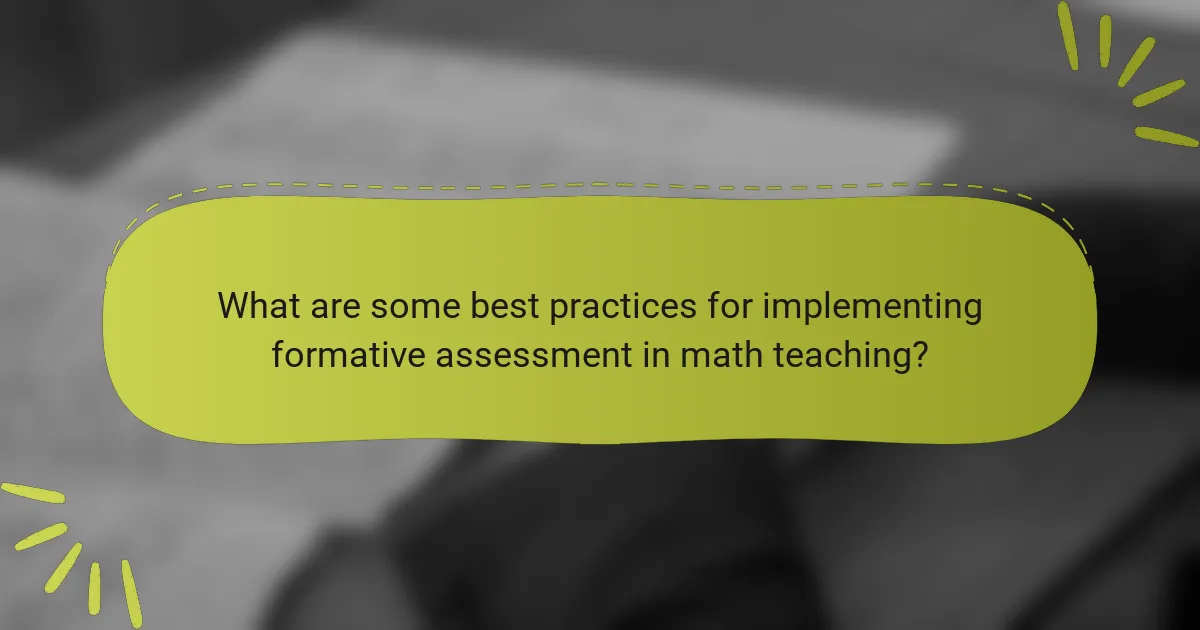
What are some best practices for implementing formative assessment in math teaching?
Effective formative assessment in math teaching involves several best practices. First, teachers should use varied assessment methods. This includes quizzes, discussions, and observational assessments. Second, timely feedback is crucial. Providing feedback shortly after assessments helps students understand their progress. Third, assessments should be aligned with learning objectives. This ensures that they measure the intended skills and knowledge. Fourth, involve students in self-assessment. This encourages reflection on their learning. Fifth, use data to inform instruction. Analyzing assessment results helps tailor teaching strategies to student needs. Research shows that formative assessment can significantly enhance student learning outcomes. For instance, a study by Hattie and Timperley (2007) highlights the positive impact of feedback on student performance.
How can teachers create a supportive environment for formative assessments?
Teachers can create a supportive environment for formative assessments by fostering open communication and trust. This involves encouraging students to express their thoughts without fear of judgment. Teachers should provide constructive feedback that focuses on improvement rather than solely on correctness. Establishing clear learning objectives helps students understand the purpose of assessments. Incorporating collaborative activities can enhance peer support and engagement. Regularly checking in with students allows teachers to address concerns and adapt instruction. Research shows that a positive classroom climate enhances student motivation and performance. For example, a study by Hattie (2009) indicates that feedback is one of the most influential factors in student achievement.
What resources are available to help teachers improve their formative assessment skills?
Resources available to help teachers improve their formative assessment skills include professional development workshops, online courses, and instructional books. Professional development workshops often focus on practical strategies for implementing formative assessments in the classroom. Online courses provide flexible learning options and cover various assessment techniques. Instructional books offer in-depth insights into formative assessment practices. Additionally, educational websites and platforms provide access to assessment tools and templates. Research studies highlight the effectiveness of these resources in enhancing teachers’ assessment skills. For instance, a study by Black and Wiliam (1998) emphasizes the positive impact of formative assessment on student learning outcomes.
How can collaboration among educators enhance formative assessment practices?
Collaboration among educators can enhance formative assessment practices by fostering shared expertise and resources. When teachers work together, they can develop common assessment strategies. This collaboration promotes consistency in evaluating student understanding. Educators can share insights on student performance and effective feedback methods. Research indicates that collaborative practices lead to improved student outcomes. A study published in the “Journal of Educational Psychology” found that teachers who collaborated saw a 20% increase in student achievement. Additionally, collaboration encourages the exchange of innovative assessment techniques. This leads to more diverse and effective formative assessments. Overall, collaboration builds a supportive environment for continuous improvement in assessment practices.
What common challenges do teachers face with formative assessment in math?
Teachers face several common challenges with formative assessment in math. One challenge is the time required to effectively implement assessments. Teachers often struggle to balance instructional time with assessment activities. Another challenge is the difficulty in interpreting assessment data. Teachers may find it challenging to analyze results and adjust instruction accordingly. Additionally, there can be a lack of resources for creating effective assessments. Limited access to tools and materials can hinder the assessment process. Furthermore, teachers may encounter resistance from students. Some students may not engage with assessments or may feel anxious about them. Finally, professional development opportunities on formative assessment may be inadequate. Teachers often need more training to effectively use assessments in their teaching.
How can teachers overcome these challenges effectively?
Teachers can overcome challenges in formative assessment by implementing structured strategies. First, they can utilize clear learning objectives to guide assessments. This ensures that assessments align with desired outcomes. Second, teachers can incorporate regular feedback mechanisms. Frequent feedback allows students to understand their progress and areas for improvement. Third, they can employ diverse assessment methods. Using quizzes, peer assessments, and self-assessments caters to different learning styles. Additionally, collaboration among teachers can enhance assessment practices. Sharing insights and strategies can lead to improved outcomes. Finally, ongoing professional development is crucial. Training helps teachers stay updated on best practices in formative assessment.
What strategies can be employed to ensure student engagement during assessments?
Incorporating interactive elements is a key strategy to ensure student engagement during assessments. Interactive assessments can include group discussions, peer reviews, and hands-on activities. These methods encourage collaboration and active participation. Utilizing technology, such as online quizzes or gamified assessments, can also enhance engagement. Research shows that students are more motivated when assessments are enjoyable and stimulating. Providing immediate feedback during assessments helps students understand their progress. This feedback allows for reflection and improvement. Additionally, offering choices in assessment formats can cater to diverse learning styles. When students have a say in how they demonstrate knowledge, their engagement increases.
What practical tips can teachers follow to maximize the impact of formative assessments?
Teachers can maximize the impact of formative assessments by incorporating timely feedback. Providing immediate feedback helps students understand their learning gaps. Regularly using varied assessment methods engages different learning styles. Incorporating self-assessment encourages student reflection on their progress. Setting clear learning objectives guides students in their learning journey. Using data from assessments to inform instruction allows for targeted teaching. Collaborating with peers to share assessment strategies enhances overall effectiveness. Finally, involving students in the assessment process fosters ownership of their learning.
The main entity of this article is formative assessment in math teaching. The article emphasizes the critical role of formative assessment in enhancing student learning outcomes by providing ongoing feedback that allows for real-time adjustments in instruction. It distinguishes formative assessment from summative assessment, outlines key characteristics and benefits, and discusses effective strategies for implementation, including the use of technology and collaborative methods. Additionally, the article addresses the frequency of assessments, challenges faced by educators, and practical tips for maximizing their impact in the classroom.

